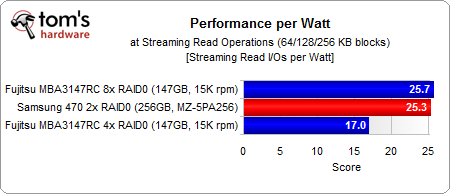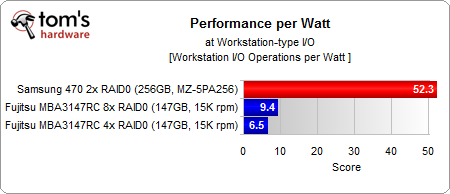How Do SSDs Redefine Storage Performance?
It only takes one or two modern SSDs to outperform business-class RAID arrays with four or eight hard drives. We're running a full comparison and looking at the implications for high-performance systems when you make the transition to flash-based tech.
Benchmark Results: Performance Per Watt Efficiency
Power efficiency matters these days. As energy costs climb, more people want the highest performance with the lowest possible power consumption. Reducing power consumption yields dividends because it also means reducing cooling power consumption. Let’s relate the measured performance to the power required for each of our configurations.
We’ve seen that our RAID with eight hard drives is capable of delivering almost 1 GB/s peak throughput, but the system requires considerably more power to operate. At the same time, our system with two SSDs delivers only 530+ MB/s maximum throughput, but it requires significantly less power to reach this level. Knowing that the 530 MB/s is sustained while the hard drive array’s throughput might drop, it’s safe to say that the SSD solution is favorable unless you really need top speeds.
Power efficiency for the workstation I/O workload is five times higher on the SSDs because of much decreased SSD system’s power consumption paired with a strong increase in I/O performance (2x up to 12x). If we were to look at power efficiency on a drive level, then the differences would be even more significant. However, in the context of everyday workloads, it makes more sense to look at system power. Now try to imagine how power efficiency would look if we relate the SSDs’ stellar Web server I/O performance results to the decreased power consumption. We didn’t run these numbers, but the SSDs would probably show a 20x to 30x improvement in power efficiency.
Get Tom's Hardware's best news and in-depth reviews, straight to your inbox.
Current page: Benchmark Results: Performance Per Watt Efficiency
Prev Page Benchmark Results: System Power Requirement Next Page Conclusion
